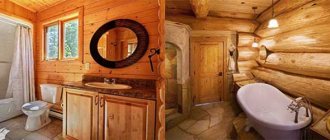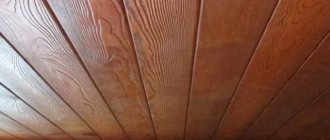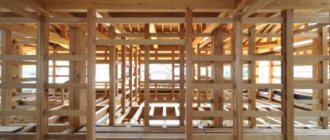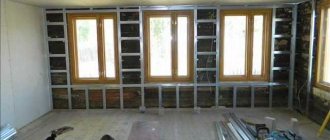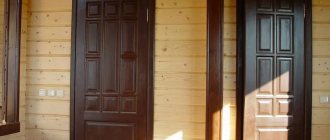Buying a new wooden country house usually involves many problems and worries. However, if your home design includes a bathroom, consider that the lion’s share of all problems have already been solved. A bathroom in a wooden house is the most difficult part of construction; no other living space requires as much attention and labor. Literally everything matters: the location of the bathroom and shower, the size of the room, proximity to water, good ventilation. In addition to designing sewerage and ventilation systems, it is necessary to carefully consider the design of waterproofing and issues of further finishing of the room.
Content:
- Finishing a bathroom in a wooden house
- Finishing the floor in the bathroom
- Wall decoration in the bathroom
- Ceiling decoration in the bathroom
- Choosing the location of the bathroom in a village house
- Choosing the optimal type of bathroom
- Combined bathroom
- Separate bathroom
- Selecting drain type
- Optimal bathroom sizes
- Features of arranging a hygienic room in a wooden building
- Supplying water to a bathroom in a wooden house
- Sewage connection
- Organization of ventilation
- Instructions for self-arrangement of a bathroom in a wooden house
- Video on the topic of a bathroom in a wooden house
A bathroom is an important component of any room, providing its residents and guests with the proper level of comfort. A bathroom in a wooden house, like in any other type of housing, has its own subtleties in organization and operation. This part of the interior can be equipped either on your own or with the help of qualified specialists. In any case, home owners are advised to familiarize themselves with the basic principles of proper organization of this place.
Peculiarities
The difficulties arise from the fact that the construction of a bathroom is not just the installation of plumbing, but also the creation of “infrastructure” (water supply, sewerage, protected electrical wiring with a water heater and ventilation).
Considering that communications are installed in a wooden building, the matter should be approached with special care.
A bathroom in a log house has replaced amenities in the yard. Accustomed to doing everything themselves, owners of wooden houses, when starting to build a bathroom, should familiarize themselves with the rules and sequence of operations. You also need to acquire the necessary tools and materials so that you don’t have to disassemble and redo the structure later.
Installing a bathroom in a log house requires skills in different areas. The construction of a house made of timber itself consists of a number of stages and is distinguished by some features.
One of them is shrinkage. To solve this problem, dampers are used. It is recommended to build a sliding frame in the house.
The next important feature is hygroscopicity and the risk of fungus appearing due to high humidity. It is almost impossible to remove it from a tree, so it is necessary to prevent its appearance. To do this, at a certain stage, the room in which the bathroom is installed is antiseptically treated, and ventilation is installed. Simple ventilation can be done by making a hole under the ceiling. By installing forced exhaust, you can increase the efficiency of ventilation.
Another feature is the need to protect pipes from freezing. You can use both traditional materials for thermal insulation of pipes and modern heating cables. The pipes are equipped with a tap for draining water.
Finishing a bathroom in a wooden house
Decorating a bathroom in a house made of wood requires compliance with certain rules, which primarily concern the materials used for coatings. Each surface of a given room is subject to different loads, so the choice of materials is based not only on the future appearance of the interior, but also on its practicality.
Communications
Installation of communications in a wooden house also has its own characteristics. The first thing that a master planning the supply of water and drainage of wastewater should remember is that wood is subject to seasonal fluctuations. During operation, the building sags and the length of the walls changes noticeably.
- This does not mean that it is impossible to make warm toilets in village houses, it just requires a special approach to laying internal communications. To do this, damping devices are used or gaps are left to compensate for shifts in wooden structures.
- Work begins with the sewer. It is better to use a plastic pipe with a diameter of 100–120 mm for this. A gutter is made in the foundation into which the drain is placed. Under no circumstances should the pipe be routed through walls; it must rest on a stable foundation. Inside the house, the riser is secured using elastic hangers; when passing through the walls and ceilings, holes are cut with a margin.
- Most likely, the sewer outlet will have to be insulated. The need for this activity is determined by the local climate and the depth of the pipe. It should lie below the soil freezing level.
- Next, the water supply is installed. The main requirement for it is complete tightness. Pipe joints must be visible. You cannot hide the joints inside the walls. This will not allow you to notice the leak in a timely manner and take measures to eliminate it. In the future, the pipelines can be closed with a box, providing technological hatches in it.
Finishing the floor in the bathroom
The base of the floor is a concrete screed, which has a slight slope, allowing moisture to drain into the drain hole. For screeding, liquid compounds, multilayer systems (dry screed), or solutions prepared with your own hands are used.
The following materials are most often used as flooring:
- Ceramic tile;
- Laminate;
- Board or sheets of moisture-resistant wood;
- Linoleum.
Regardless of what design of a bathroom in a wooden house will be chosen, the main criterion that the finishing material will have to meet is moisture resistance. The most practical among the products presented is ceramic tiles. It does not allow water to pass through, washes well and keeps its shape. The most affordable in terms of cost savings is linoleum. All hard coverings must have a small (up to 2cm) gap to the walls to compensate for subsequent movements of wooden structures.
Materials and tools
A prepared room diagram will allow you to quickly and accurately calculate the amount of material used, and a work plan will help you select the right tool. In general, to make a bathroom you will need the following materials:
- pipes for water supply, sewerage and ventilation (it is better to choose modern plastic);
- roll waterproofing;
- sheet material for sheathing (waterproof OSB board, plywood or plasterboard);
- slats or metal profile for making sheathing;
- flooring (laminate, tile, linoleum);
- fasteners (self-tapping screws, screws, nails).
We still need doors. Any kind will do, but from an aesthetic point of view, wooden ones are preferable. In addition to the material, you need a tool.
The list varies significantly depending on the specific project:
- saw (hacksaw or electric circular saw);
- screwdriver or electric drill with an attachment;
- Screwdriver Set;
- hammer;
- ruler, pencil, tape measure.
Important! When choosing materials for finishing a bathroom in a wooden house, you should under no circumstances try to save money. Low quality material will not provide adequate protection for wooden walls, which will cause unscheduled repairs.
Wall decoration in the bathroom
Basically, moisture-resistant plasterboard attached to a metal frame is used to decorate the walls in the bathroom of a wooden house. This allows you to easily cover the walls with any suitable material in the future.
The following claddings are considered the most common:
- Tiles are the most practical materials that are not afraid of deformation under the influence of changes in temperature and humidity;
- Moisture-resistant wooden lining, treated with special coatings, perfectly emphasizes the naturalness and environmental friendliness of the building as a whole;
- Plastic in the form of panels is available in a wide range, but requires good ventilation.
Carrying out interior work
When organizing an internal sewerage system, many prefer to use independent frames. Communications are laid directly in the frame base.
When making such a design, you should consider:
- To secure the frame material, special profiles (U-shaped) are required;
- Parts of the structure should be attached to the main walls using brackets with grooves, but there should be no strong tightening in screw connections;
- Communications and electrical wiring are laid in the resulting gaps;
- You can assemble the frame structure yourself, because there are many options for this product.
Before finishing finishing work, you need to level the walls and floor.
Experienced craftsmen advise using polypropylene products to install water supply and sewer systems. Such materials are lightweight and highly durable. You can easily assemble the chosen scheme, because the individual parts fit perfectly together and are easily connected.
When organizing pipe turns, care should be taken to install an inspection designed to clean the pipeline. To increase the strength of the internal network, all seams and joints of the structure must be sealed.
Ceiling decoration in the bathroom
When thinking about how to cover a bathroom, you should pay special attention to the ceiling. This part of the finishing is made suspended from moisture-resistant plasterboard and lining, or tensioned from polyvinyl chloride. Suspended structures make it easy to install almost any lighting, and also perfectly retain moisture. In addition, it is easier to organize ventilation under a suspended ceiling.
Tile base
Moisture-resistant sheet material is attached to the sheathing. The priority here is moisture-resistant drywall. Sometimes it is fixed in two layers - to increase the load-bearing capacity and for better heat and vapor insulation. Before laying the sheets of the second row, the joints of the first are puttied, and the gypsum board itself is positioned so that the seams of the two rows do not coincide.
- But this is still a gypsum board - an imperfect base, since both cardboard and gypsum are hygroscopic, and their absorbency is reduced by impregnation. Therefore, for greater reliability, moisture-resistant plasterboard is also impregnated with a protective compound. For example, FLACHENDICHT. This is a waterproofing material that is specifically designed for waterproofing gypsum plasterboard and other gypsum bases.
- You can also use Aquapanels from Knauf. They are made on the same principle as gypsum plasterboard, but the core is cement with filler, and the “wrapper” is fiberglass. Both materials are not afraid of moisture without pre-treatment. Their difference is that they are made absolutely smooth, without recesses along the edges that gypsum boards have. They are joined end-to-end, and a special adhesive composition is applied to the joining edges. Immediately after installation, the surface is smooth and ready for further finishing. You don't even need to putty it. Moreover, one side of the aquapanel is made smooth - for gluing wallpaper or painting, and the second is rough - for laying tiles.
- You can also use moisture-resistant plywood, GVL, as a base for tiles on walls in a timber or log house. They are also attached to the frame, leaving gaps in the seams, which are filled with silicone non-drying sealant.
Choosing the location of the bathroom in a village house
The placement of a bathroom in a private house is discussed at the design stage of the building. If the house has two floors or more, then the placement of the bathroom is primarily carried out on the first floor, and subsequent tiers are supplied with similar rooms as needed. In this case, it is advisable to arrange bathrooms strictly vertically to reduce the number of pipelines in the house.
If the housing will have several bathrooms, then when planning it is important to pay attention to the floors between floors. The large load created by filling such a room requires special strength from the load-bearing elements of the entire structure of the house.
It is recommended to place a bathroom in a dacha in a wooden house, the layout of which can be completely different, near the kitchen, as this will reduce the cost of effort and money on additional communications in the form of water supply, sewerage and ventilation.
Toilet in a country house
Many people think about how to make a toilet in the country; most summer residents still have lonely houses in their gardens. Some are trying to arrange a toilet modeled after a city one. That is, a toilet is installed, and the waste discharge passes through the sewer pipe to the drainage settling point. There should be dug or concrete rings, and a special container installed. And at least once a year you will have to call a vacuum cleaner to clean the cesspool. And in between there have appeared many options for arranging country toilets. More on this below.
Some summer residents go a different route. They simply attach an outdoor toilet to an existing house, but before attaching a warm toilet to a wooden house, they need to see how the structure of the house as a whole behaves.
Combined bathroom
The main advantage of this type of room is the saving of usable space, which in a separate structure is wasted on the partition. Here you can install additional equipment such as a washing machine, dryer and other content. Staying in such a room is relatively comfortable due to the larger space, and maintaining order is carried out in a simpler way than in separate bathrooms.
Another important point in favor of joint construction is the cost savings on building materials. In this case, there is no need to build and finish an additional wall on both sides.
Where to stop
In most cases, the most important consideration will be the overall renovation budget. If you plan to spend a not too significant amount, it is better to refuse gypsum boards - the costs here are quite large and include not only materials, but also subsequent finishing. Many people do not take into account the need to purchase putty, various primers, paint and other materials.
Stretch films are the most versatile and are not too expensive. In all respects, this is one of the best options. If there is not enough money to install such a ceiling or you want to do everything yourself, then panels or slatted structures will be the best choice. They are easy to install, and the cost of purchasing all the necessary materials is low.
Separate bathroom
A separate bathroom in a private wooden house is more convenient to use than a combined one if two or more people live in the house. In such an environment, you won’t have to wait for your turn in the bathroom if it is occupied by a person with completely different purposes.
A very significant advantage of such a project is more precise control of humidity in both rooms, which makes it easier to maintain order in each of them. In addition, a divided bathroom can be decorated in different styles.
The disadvantage is the excessive crampedness of the room with the toilet, which usually saves usable space.
Waterproofing
Maximum attention is paid to waterproofing a wooden house. This is more than important; water seeping through the cracks in the finishing will cause the wall to lose strength, resulting in destruction of the wood and expensive repairs.
- Rolled waterproofing will help you quickly and efficiently create protection from moisture. This can be classic roofing felt or modern fiberglass-based products. Roofing felt can only be used as a last resort; it is essentially paper, which is not conducive to the durability of the coating.
- The first step is to protect the floor. The sheets are laid on a backing made of waterproof wood board or on a concrete base. Each subsequent sheet should be overlapped and the surface should be heated.
- When installing bathrooms in houses made of timber, it is enough to soak the walls with an antiseptic. If subsequent cladding is planned, they are also covered with rolled material. The principle applies here: there is no such thing as excessive waterproofing.
Selecting drain type
Depending on the method of waste disposal, bathrooms can be divided into dry toilets, powder closets, and backlash closets.
A dry toilet consists of a toilet seat and a reservoir installed underneath it, in which, as a result of chemical or biological reactions, human waste products are converted into water or compost.
Powder closets are connected to boxes in which peat must be periodically added to convert waste into dry matter. The boxes are cleaned as they are filled.
Backlash closets are insulated toilets attached to the house. The drain is organized into a pit.
The working process
- Before you start arranging a bathroom, you need to study the step-by-step instructions. The installation of a bathroom should begin with waterproofing. It is necessary to pre-impregnate the wood with an antiseptic. All surfaces are treated from the inside with a water-repellent compound.
- Then the metal frame is installed. It is covered with moisture-resistant material. The joints are also treated. The brand of composition and method of application are selected depending on the type of surface.
- Roofing felt is not the best choice for indoor waterproofing (high cost, not environmentally friendly). It is better to use a water-repellent mixture. Thanks to it, the surface is covered with a moisture-impermeable membrane.
- You can use rolled materials. Glued to the surface, they protect it from moisture.
The floor and ceiling are most vulnerable to moisture. You can additionally protect areas prone to it with ceramic tiles. It is glued to a leveled surface. A suspended ceiling will allow you to hide ventilation ducts and install lamps. The walls are sheathed with waterproof plasterboard, which is secured with self-tapping screws to a frame made of a metal profile. The frame is made from “box” profiles (two connected U-shaped profiles). Holes are pre-drilled in the slabs for installation of electrical wiring.
You can lay out ceramic tiles for finishing. A sliding frame is a structure that compensates for shrinkage. It is made according to markings on the walls made of metal profiles.
Gypsum fiber sheets are cut. They break easily along the cut line. Metal guides are cut with a grinder or special scissors. The frame is installed using self-tapping screws. The internal space is filled with stone wool. After covering with sheets, the seams are puttied.
Optimal bathroom sizes
When wondering how to make a bathroom in a wooden house as ergonomic as possible, you first need to think about its size. The dimensions of the bathroom are mainly dictated by its contents (plumbing, appliances, appliances) and the space available according to the design. If the bathroom is separate, then an area of up to 3 square meters will be enough to install a washbasin and toilet in the toilet. For a separate room with a shower, the same space is enough.
A combined bathroom, which will contain a toilet, shower and sink, requires an area of 4 sq.m., taking into account the fact that no household appliances will be located here.
To equip a room with a bathroom, an additional cabinet and, for example, a washing machine, its dimensions must be at least 5 square meters. In addition, both the shape of the room itself and the way all elements are placed are very important, so it is recommended to think in advance about the location of the water supply and sewerage for a more successful arrangement of all objects.
Location and dimensions
Ideally, a room for a bathroom is chosen at the stage of preparing the house plan. In practice, everything can be different; quite often it is necessary to rebuild an already completed building. When choosing a room in which the bathroom will be located, you should follow the recommendations:
- the toilet should be located next to the living room, on the floor below it, but not above it;
- one of the walls should be external, which will simplify the creation of ventilation;
- in a multi-storey building, bathrooms are installed one above the other, this will facilitate the laying of communications and their subsequent maintenance.
The dimensions of the room are determined individually for each specific project. This is influenced by a number of factors:
- type of bathroom (separate or bathroom with toilet);
- number of bathrooms;
- dimensions of a residential building;
- physical characteristics of people.
Important! When planning a bathroom, it is necessary to proceed from construction standards. The dimensions of the toilet must be at least 0.8 × 1.2 m, the size of the toilet with washbasin must be 1.6 × 2.2 m. A full bathroom with a bathtub can be located in a room measuring at least 2.2 × 2.2 m.
It is mandatory to make a schematic drawing of the room allocated for the bathroom. The dimensions of the plumbing fixtures and their installation locations are marked on it. It is also important to consider the location of the pipelines. The bathroom must be planned in such a way that the distance from the toilet to the sewer riser does not exceed 1 m, and from the bath – 3 m. Otherwise, you cannot do without pumping equipment.
In the case of a country house with several floors or a cottage with an attic, it is worth considering the option of placing a toilet and bath under the stairs. This will make it possible to significantly save space without sacrificing convenience. The bathroom can be attached to the main building, since the design of a wooden house makes this easy to do.
Features of arranging a hygienic room in a wooden building
An important feature of arranging a bathroom in a wooden house is the waterproofing of the room. The porosity of wood causes it to constantly absorb and release moisture, so insulating it from the high humidity of the bathroom is mandatory.
Despite the success of protecting the tree from steam, it still absorbs water from the atmosphere, so it is in a constant mode of expansion and contraction. This produces linear movements of the entire structure of the house, so the bathroom is integrated into the house on the basis of a sliding frame. This method eliminates the interaction of the bathroom with the main structure of the house, which will protect its owners from the destruction of hard and fragile elements of the interior decoration of the room.
Briefly about the renovation
Sooner or later you have to start renovating your bathroom. It’s better not to make do with half measures, but to open the skin completely to assess the condition of the waterproofing and wooden elements.
The affected areas of the sheathing are replaced, and the wood is treated comprehensively. The damaged canvas is sealed with adhesive sealing tape, and in no case with tape. It is advisable to use products from the same manufacturer, due to possible chemical reactions.
For local repair of wet joints, ready-made KNAUF latex waterproofing is suitable. Before any work, the room and structures should be dried. Wet insulation loses its properties.
Remember the difference between a vapor barrier film and a vapor-windproof membrane. The first is to prevent vapors from entering the house structure. The second one works in a mirror way: it does not allow street moisture to pass through, but releases air to the street; do not confuse the sides when replacing.
Supplying water to a bathroom in a wooden house
Having chosen a suitable place in a wooden house for arranging a hygienic room, you should proceed to the issue of supplying the appropriate communications to it. The easiest way to connect a bathroom is in a wooden house, the planning of which is at the initial stage of implementation. An important point in this matter is the choice of material from which the pipes are made.
It should be remembered that wood is very sensitive to moisture, so it is recommended to exclude metal pipes from the water supply system, on which condensation constantly forms. Plastic products must be used.
To maintain the integrity of the wooden elements, it is necessary to ensure their minimal contact with the pipes. It is also recommended to use thermal insulation for pipes and clamps with rubber gaskets.
How to make a floor
The floor in a bathroom in a wooden house can be made of any waterproof material. Traditionally, this is ceramic tiles or porcelain stoneware, but you can put linoleum (an economical option), PVC tiles (the quality and characteristics of the coating are similar to commercial-grade linoleum), adhesive plug (it is 100% airtight, as it is covered with several layers of varnish).
You can even make a wooden floor, but the board will need to be treated with special compounds and care must be taken to ensure ventilation of the underground space.
All coatings except wooden boards are compatible with heated floors. This can be water or electric heating. Only when choosing a floor covering, pay attention to its compatibility with heated floors. In this case, it is better to take ceramic tiles that are not very thick - to speed up the heating of the array, but in principle, any one is suitable.
The characteristics of other materials must indicate compatibility with heated floors.
A bathroom in a wooden house is most often finished with tiles. In any case, the floor is made mainly from this material. It is practical and easy to care for. Ceramic floor tiles or porcelain tiles can be laid on a cement or dry screed. Moisture-resistant plywood, gypsum fiber board, and chipboard are used as a base for dry screed. There is also a new material that can be used in dry screed - Aquapanels from Knauf.
If necessary, you can lay a film heated floor on a dry screed, and the selected finishing material on top. You can lay water heated floors or cable mats in the cement (you can just use a heating cable). It is not advisable to use a film floor in a screed, since the film in concrete quickly breaks down and heating simply stops working.
For all other types of bases, these two types of base can also be used. There is only an additional requirement for the screed: for linoleum, PVC tiles and cork, the base must be strong and level. The permissible deviation is 2 mm per 2 meters. Therefore, a regular screed is also filled with a self-leveling mixture.
Cement screed on wooden floor
Typically, finishing the bathroom begins after the subfloor is ready. If you decide to make a cement screed, the procedure is as follows:
A waterproofing roll material is laid on the base. This can be rolled Gidroizol or other similar materials. Thick polyethylene film (density 250 g/m or more) is suitable as an economical option. Waterproofing is installed according to all the rules: with overlaps of one sheet over another, carefully gluing the joints with mastic. In addition, the material extends about 20 cm from the walls (they are also coated with mastic).
A reinforcing mesh is laid on top of the waterproofing. Since the room is small, a ready-made reinforcing mesh made from a rod 5-8 mm in diameter is sufficient. You can attach water heated floor pipes or a heating cable to this mesh.
- The mesh is placed on special stands (pebbles about 3 cm high can be used). The point is that the reinforcing mesh should be in the thickness of the concrete and not rust, and a 3 cm layer of concrete can protect it.
- Fill with concrete and level. The minimum thickness of the concrete screed is 5 cm.
- After the concrete has gained strength (one to two weeks depending on the temperature), you can glue the tiles to the floor or lay a suitable other type of flooring.
There are some other points. To avoid water flowing between the screed and the wall, it is advisable to first seal the joint around the perimeter with waterproofing tape (available from Knauf), or you can coat it with liquid waterproofing. The next point: before starting to lay the tiles, the surface is dust-free (cleaned well with a vacuum cleaner), then primed (for cement bases under the tiles). The soil reduces the absorbency, which allows the glue to gain strength rather than dry out due to the fact that all the water has gone into the concrete.
In this case, a bathroom in a wooden house will not create problems for its owners - the tiles on the floor will lie for years and will not bounce off.
Dry screed
To make a tile floor in a bathroom in a wooden house, it is not necessary to use cement. You can make a so-called dry screed. Moisture-resistant sheet material is laid on the subfloor. It can be plywood, chipboard or gypsum fiber board. The best option is plywood with a thickness of at least 14 mm. Chipboard can also be used, but it is more susceptible to warping when humidity increases. GVL has not shown itself very well in operation - it does not tolerate shock loads well (it can crack upon impact). Therefore, it is advisable to still lay plywood.
- It is laid staggered so that the seams do not match. A gap of 3-4 mm is left between the sheets. It is needed to compensate for thermal expansion as the temperature rises. Fasten the plywood along the perimeter with nails to the subfloor, then in the middle in a checkerboard pattern (the distance between the fasteners is about 15 cm). The seams are sealed with a moisture-resistant sealant, which does not become rigid after drying.
- Since tiles require a rigid base, a second layer of the same plywood is often laid. They lay it according to the same principle - with staggered intervals, but so that the seams of the first and second layers do not coincide. The rules are the same, only the second row is attached to the first, and not to the subfloor.
- A waterproofing tape is glued along the perimeter of the made base (Knauf has it). In addition, even though plywood is moisture resistant, it is advisable to cover it with a layer of liquid waterproofing. Just choose the composition on which you can lay the tiles. After drying, you can immediately begin laying the tiles.
Sewage connection
The wooden structure of the house is very sensitive to leaks, so particularly strict requirements are put forward for sewerage in such housing. You should choose reliable drain systems with strong joint locks.
An important point is to prevent the drain from freezing. If pipes pass near ventilation ducts, then in severe frosts outside, severe cooling of the drain may occur. In such cases, thermal insulation is used, as well as drainage as far as possible from the street, digging it as deep as possible into the ground.
Do-it-yourself sewer system organization
When creating an individual sewerage system in a village building, it should be taken into account that the transportation of waste liquid can be gravity or forced.
They are characterized by the following:
- The gravity system operates under the influence of gravitational forces. It is enough to install the pipeline at the required angle, and the drains freely penetrate into the cesspool.
- For the pressure (forced) system, a special fecal pump is used, through which the wastewater moves.
Both of the above options can be used to create an individual sewer system.
If you decide to use a gravity sewer, it is important to maintain the slope correctly. The digging of the pipe is carried out in compliance with a uniform slope. Experts recommend not making a very steep slope. In this case, the pipeline will not have time to fill with water, resulting in poor flushing of the pipe walls.
A drain slope that is too level is also not suitable for sewerage. Often, due to low speed, the pipeline becomes clogged.
If you are not confident in your abilities, then it is better to hire a specialist to carry out sewerage.
A pressure system for transporting wastewater is often used if it is not possible to organize gravity drainage of liquid. By means of a fecal pump, forced movement of waste occurs. The equipment fits well into any toilet and ensures trouble-free operation.
Organization of ventilation
Air exchange in the bathroom plays an important role in maintaining the cleanliness and integrity of finishing materials. Here it is necessary to ensure effective air flow from the main room. To do this, select doors with holes at the bottom, allowing air to enter into the lowest point of the bathroom.
To draw air from the house into the upper part of the wall opposite the door, an exhaust hood is mounted. As part of fire safety regulations, this device is equipped with a special valve.
Air exhaust is organized directly to the street, or through a channel passing under the attic.
How to make a sheathing
When making lathing in a wooden house, it is worth remembering that it constantly changes dimensions. Several years after construction, it actively shrinks and takes on operational dimensions. But even then, throughout the entire period of operation, it changes slightly in size. This phenomenon is called seasonal fluctuations. Therefore, you should not firmly fasten the sheathing - it can break and all the finishing will fall off.
If you do the finishing without taking this feature into account, the bathroom in a wooden house will be a source of problems - the tiles from the walls will crumble or burst.
Therefore, the sheathing strips are made a little shorter so that they do not reach the floor and ceiling. The second point is that they are not attached directly to the wall, but through special devices. For fastening wooden blocks there are metal corners with slots on one of the shelves. These are the fastenings for the floating sheathing device (pictured on the left). They are rigidly attached to the sheathing bar, and to the wall of a wooden house - through a slot using a self-tapping screw with a large flat head or a bolt with a washer. It turns out that when the wooden wall moves vertically, the sheathing on it will be in the same position.
The second way to make a floating sheathing in a wooden house is to make several through cuts about 10 cm long in the block using a hand router. Through this cut, fix the beam to the wall using the same wood grouse with a washer. To prevent the bolt head from sticking out, use a router to make a recess. Its depth is equal to (or slightly greater than) the height of the bolt head, and its width is the size of the washer (pictured on the right).
For a newly built house, the fasteners are installed in the upper quarter of the cut, for an established house - approximately in the middle.
As for galvanized profiles, they are attached to the same corners for floating sheathing. The second option is perforated hangers. This type of fastening is not as reliable, but still allows some freedom of movement. Perforated hangers can be used in an established wooden house where movements are already small.
Instructions for self-arrangement of a bathroom in a wooden house
In order to successfully provide a wooden house with a bathroom with a toilet, or separate toilets, it is not necessary to resort to the help of specialists. By following the recommended steps, you can arrange a bathroom in a wooden house with your own hands:
- Determine the location of the bathroom;
- Organize drainage;
- Provide ventilation;
- Connect the water supply;
- Ensure waterproofing of the room;
- Install plumbing;
- Finish the work done.
Despite some difficulties associated with arranging a bathroom in a wooden house, this task is within the power of even the homeowners themselves. A variety of ways to organize and design the interior allows you to make the room as ergonomic and comfortable as possible.
Sewerage using a cesspool
The simplest way to organize sewerage in a country house is to use a cesspool. Before starting work, it is necessary to determine the location of the waste container. The cesspool should not be located close to the water intake point (less than 20 m), this will help prevent wastewater from mixing with water.
When building a cesspool with your own hands, you should follow the sequence of work:
- When digging a hole, make sure that its depth is at least 1.5 meters;
- It is recommended to make the bottom at a slight slope, due to this, heavy inclusions will settle in the bottom part;
- It is important that the design provides high-quality waterproofing;
- In order for a pit in the village to last a long time, the walls of the tank should be lined with bricks, and the bottom can be filled with concrete;
- To reduce hygroscopicity, the entire surface should be treated with a primer, and then the inside should be finished with waterproof plaster;
- It is preferable to make a double lid for the cesspool, where the inner part is made of wood and the outer part is made of metal;
- Care should be taken to insulate the structure; insulation (glass wool, peat) is located between the covers.
Plastic pipes are well suited for sewerage.
When organizing the pipeline, it is important that there is a slope along which the drains can easily penetrate into the pit.
How to arrange a water supply
When building a bathroom in a cottage, it is worth paying great attention to protecting the water supply. Water supply networks face a serious danger - defrosting at sub-zero temperatures. Private houses where the owners come during the season are especially susceptible to this problem.
To prevent such a situation, you must follow the rules:
- Insulate the floor with film and expanded clay.
- Insulate pipes with modern thermal insulation materials.
- Provide a drain valve at the lowest point of the water supply system. This is necessary for high-quality drainage of residues in the absence of home owners.
Sliding frame - what is it?
Wooden houses have one common characteristic - the wood settles over time. To prevent obvious deformation, you need to install a special supporting structure - a sliding frame.
To install it you will need a metal profile. It should be attached to the wall only with the flat side. Calculations should also be carried out before installation.
Several important nuances when installing a sliding frame:
- The cord should be pulled according to the pattern “along the entire wall from top to bottom.” The distance from the floor should be no more than 10 cm, and from the ceiling - no more than 70 cm.
- Marks should be made on the wall as the work progresses so that you can navigate by them while laying drywall.
- Drywall sheets must be laid so that they overlap each other.
- There should be a distance of approximately 40 cm between the ceiling and the ceiling. This area can be used for ventilation or electrical wiring.
You should also carefully select the profile and fastenings to it. It must be mobile and pliable. The profile is attached using special screws. They do not need to be tightened too much for the structure to be movable. This measure will help protect against deformation if the tree “sits.”
The advantage of a sliding frame is that it is autonomous and independent of the structure. The walls will not affect the structure, so this technology is an important safety measure.
Ventilation system
For natural exhaust, you can make a hole in the outer wall. A bent metal pipe is connected to it. Its upper end should be located above the roof level. A metal cone is installed to protect against precipitation.
Natural ventilation can be provided in the finished ceiling cladding. To do this, you need to cut a hole above the toilet. To increase air exchange, you can make an additional outlet in the opposite corner. All openings are covered with decorative grilles, matched to the main design of the room.
Forced ventilation is provided by installing special devices and systems. They are installed inside the toilet room.
